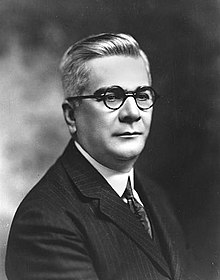Presidio Modelo
The Presidio Modelo (Spanish for model prison ) was a penal institution based on the model of the Panopticon on the Cuban island of Isla de la Juventud (then Isla de Pinos ).
history

The construction of the complex, which consists of four round building complexes and a central dining room, began on February 1, 1926 under dictator Gerardo Machado and the prison was opened on September 16, 1931.
During the Second World War , two of the buildings belonging to the prison were used to house interned German and Japanese nationals.
Most of the insurgents who survived the attack on the Moncada barracks in 1953, such as B. the brothers Fidel and Raúl Castro , Ramiro Valdés , Juan Almeida or Mario Chanes de Armas were interned in the Presidio Modelo from 1953 to 1955.
For the prominent political prisoners , however, there was a separate wing in which they were kept isolated from the other prisoners. In this rectangular room in the former infirmary, one bed stood next to another and the lights were never turned off. For this wing there was a sanitary room with three showers, two toilets and a washbasin.
After the victory of the revolution led by Fidel Castro in 1959, the Presidio Modelo was used to intern political opponents, counter-revolutionaries, homosexuals, Jehovah's Witnesses and other people who did not fit into the new socialist state. The several thousand political prisoners imprisoned here after the Cuban Revolution included Huber Matos , Eloy Gutiérrez Menoyo , Armando Valladares , Luis Andrés Vargas Gómez , Pedro Luis Boitel and those convicted of war crimes against members of the Cuban Air Force in 1959 .
The total of five round buildings, of which the middle was the dining room, were originally designed for around 465 inmates each, but in fact the prison was often overcrowded with 6,000 to 8,000 inmates. As a result, there were several prison riots and hunger strikes in 1961 among the mainly political prisoners of the new Castro state. According to statements from prisoners at the time, shortly before the invasion of the Bay of Pigs in 1961, preparations were made to blow up the prisons (including the inmates) in the event of an attempt at liberation using TNT charges in the underground passages. The explosive charges were removed after the missile crisis in autumn 1962.
The prison was closed in 1967, declared a national monument, and now houses a museum. So you can z. B. visit the beds in which prominent prisoners are said to have been. A primary school is now housed in the former administration building.
Panoptikum architecture
The round prison structure of the "F-House N ° 1" in the Stateville Correctional Center in the US state of Illinois, which opened in 1925 and closed in 2015, was probably used as a model .
Originally, eight round buildings were planned in Cuba, four of which were ultimately built in Panopticon style with a central building as a dining room, which could seat up to 3000 people.
On a total of five floors there were numbered cells all around, a total of 465 per building. Each of the cells was 3 meters long, 1.80 meters wide and 2.50 meters high and originally designed for two people each. They were all equipped with two beds, a toilet and a vanity. All cells in the Panopticon could be viewed unobserved around the clock from a central tower that was only accessible via an underground passage. On the first floor, the showers were along the wall.
The Pentonville Prison and the Holloway Prison in London, Port Arthur on the Australian island of Tasmania, the Carcere di San Vittore in Milan and the now demolished Lehrter Strasse cell prison in Berlin were built even earlier than the Presidio Modelo .
literature
- Pablo de la Torriente Brau: Presidio Modelo. Instituto Cubano del Libro - Editorial Ciencias Sociales, La Habana 1969 (2nd edition, ibid 1975).
Newspaper article by Pablo de la Torriente Brau about his experience in prison:
- Suicidados
- Fugados
- Enterrados vivos
- La isla de los 500 asesinatos
- Una serie sobre los horrores de Cambray (Carteles Magazine)
- Castells no ayudó a Machado (Ahora newspaper)
Documentaries
- El presidio plantado ( Indomitable Prisoners ), director: Luis Guardia, USA 2008, 90 min., Available on YouTube with English subtitles - documentation of the prison conditions of the political prisoners housed in the Presidio Modelo under Fidel Castro
- Presidio Modelo, director: Pablo Alvarez-Mesa, Canada 2008 (15 min)
Web links
- Presidio Modelo
- C. Kolbe: Kubas Höllenknast: “People became monsters” , Spiegel Online, January 3, 2018
Individual evidence
- ↑ A visit to the Panopticon (January 2016)
- ^ El Presidio Modelo
- ^ Presidio Modelo. In: Bohemia.cu, accessed on March 26, 2014 (Spanish)
- ↑ Haunting Images from Inside the Abandoned Panopticon Prison in Cuba ( image collection)
- ↑ Jesus Hernandez Cuellas: Chronicle of an Unforgettable Agony: Cuba's Political Prisons. ( Memento of the original from April 13, 2015 in the Internet Archive ) Info: The archive link was automatically inserted and not yet checked. Please check the original and archive link according to the instructions and then remove this notice. In: Contacto from September 1996, accessed on September 22, 2014 (English)
- ↑ Nora Gamez Torres: Presidio político de Isla de Pinos en Cuba: dinamita bajo los pies, in: Nuevo Herald of September 13, 2014 (Spanish)
- ↑ Stateville's controversial 'roundhouse' prison area shuttered (December 1, 2016)
Coordinates: 21 ° 52 ′ 40 " N , 82 ° 45 ′ 59" W.

